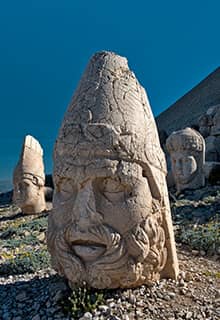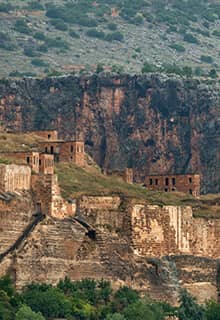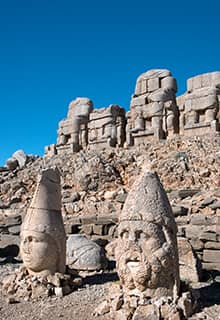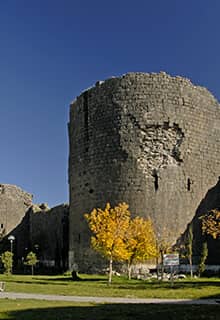

Mosaic of History
Gaziantep – Halfeti – Nemrut / Adıyaman – Diyarbakır
Southeast Türkiye forms the northern border of the Fertile Crescent, a region with rich soil and history. Fed by the waterways of the Euphrates and Tigris Rivers over thousands of years, the Fertile Crescent has been home to a variety of cultures, rich agriculture, and trade. At the westernmost point of this region in Türkiye, the city of Gaziantep is home to the ancient city of Doliche, known today as Dülük, formed over a mound in prehistoric times. Twin mithraea, underground temples for the worship of the god Mithras, were discovered in the caves of this ancient settlement dating back to the 1st-3rd century AD. These were important cult centers of Mithras in Southeast Anatolia.
Further north of Gaziantep, along the shores of the Euphrates, the Roman castle Rumkale is an ancient citadel situated on high rocks.
A church was built in the memory of Saint Nerses I (Nerses I the Great) who died in Rumkale in 1773. The church was transformed into a mosque in the 17th century. Barşavma Monastery, located on the north of the flooded citadel, was built by Saint Yakubi Barşavma in the 13th century. Some parts of the two adjacent constructions have also survived. The location holds an important place in the history of Christianity since St. John the Apostle, one of Christ’s Twelve Apostles, resided here and wrote part of the Gospel of John in a room carved inside the rocks.
Mount Nemrut, one the highest peaks of Eastern Tauros Mountains, is crowned by the colossal statues of an hierothesion (temple tombs and a house of gods) built by Antiochus I (69-34 BC) who reigned over the Kingdom of Commagene, a kingdom founded north of the Euphrates. It is one of the most ambitious constructions of the era. The fascinating sculpture of a pantheon and the lineage of its kings, which can be traced back through legends, lie on the terraces of the 2,150-meter peak of Mount Nemrut facing the city of Kahta, Adıyaman, and vast plateaus.
As you continue further east, you come across the city of Diyarbakır which was an important center during the Hellenistic, Roman, Sassanid, and Byzantine periods, through to the Islamic and Ottoman periods, and to the present. In the city’s historical citadel, known as İçkale, which is surrounded by the 6-kilometer-long Diyarbakır Fortress, there existed 22 churches belonging to various periods and faiths. Today, six of them remain standing.
Surp Giragos Armenian Church, Surp Sargis Church and Armenian Catholic Church, Syriac Protestant Church, Assyrian Orthodox Church of the Virgin Mary and Mar Yakub, Chaldean Mar Petyum Church, and Saint George Church (Black Priest, Kara Papaz) stand as historical evidence of the rich mosaic of faith that characterize this ancient region.
Saint George Church or Mar Gevergis Church, whose exact construction date is unknown, is estimated to have been built in the 2nd century AD. The church, built of cut black basalt stone, is also referred to as the "Black Priest Church" (Kara Papaz) by the locals. During the Artuqid period, the function of the church was changed and it was used as the bathhouse of the palace located on Amida Höyük. Some sources write that Ismail al-Jazari’s (El Cezeri) automata were used in the bathhouse. Considered one of the pionners of robotics in the Golden Age of Islam, El Cezeri or al-Jazari was the first scientist and engineer to carry out work on cybernetics. Following restoration work, today, St. George Church is used as an art gallery.
The latest temple of Mithra to be discovered was unearthed in Diyarbakır in 2017. Mithra’s origins are Persian and date back to the 600s BC. He was known as the god of light and the "invincible and indestructible god" among the Roman soldiers. Archaeological excavations revealed the Temple of Mithras in the Zerzevan Castle, the eastern border garrison of the Roman Empire, in 2017.
All temples of Mithraism, a religion that was difficult to enter, were built in natural underground caves or were artificially constructed beneath ground level. According to Western researchers, the first Mithras temple built in the Roman Empire was in Diyarbakır.




